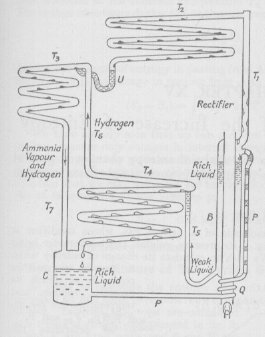|
Electrolux invented the thermodynamic cycle that is used in the gas-powered fridge and they patented it. The patent has since expired and the method is also used by Sibir. The fridge has no moving parts and is powered by a small flame or heat-source. It uses a working fluid which is a mixture of ammonia and water. The space in the pipes is filled with hydrogen and the whole thing is pressurised and sealed. 
There are three interlinked circuits in this fridge. Ammonia circulates round the outer loop B-T1-T2-T3-T7-C-P-Q-P-B. Hydrogen circulates around the left loop C-T4-T3-T7-C. A dilute ammonia solution in water circulates round the lower loop B-T4-C-P-Q-P-B. The actual cooling occurs at the evaporator, T3, (which is inside the ice box of the fridge) where pure liquid ammonia evaporates in a light breeze of hydrogen, removing latent heat and producing a cooling effect. The main ammonia cycle works like this: The boiler, B, contains a solution of ammonia in water. The heat from the flame evaporates the ammonia and some water and these vapours flow up into the condensor T1. This has colling fins on the outside and is designed so that the water condenses out and runs back into the boiler while the pure ammonia vapour continues to the second condensor, T2. The pure ammonia collects in U from where it dribbles into the evaporator T3 which is in the ice box. Some of the ammonia dribbling down T3 evaporates because there is a continuous flow of hydrogen blowing past (see below). The evaporation creates the cooling effect. The heavy ammonia vapour and remaining ammonia liquid falls down T7 into the reservoir, C. The hydrogen cycle works like this: A steady trickle of weak ammonia solution flows from the boiler, B, into the absorber, T4. This dissolves the ammonia vapour coming up from C and allows pure hydrogen to circulate up T6. The hydrogen is drawn up as the denser ammonia vapour and hydrogen mixture falls down inside T7. This hydrogen-pump creates the continuous flow of hydrogen that evaporates the ammonia in T3, cooling the fridge. The dilute ammonia cycle works like this: From the reservoir, C, the rich liquid flows along a pipe, P, to a coil where it is heated, Q. Vapour travels up the vertical part of P and into the boiler, B. This keeps the level in the boiler high enough that the diulte ammonia solution flows up T5 and into the top of T4. This solution, running down T4, attracts the ammonia vapour out of the upgoing hydrogen. The solution is dilute because it has come from the bottom of the boiler where the denser, weak solution, sinks. Ammonia solution in water is less dense than water. Now how on earth did anyone manage to invent something as clever as that? |